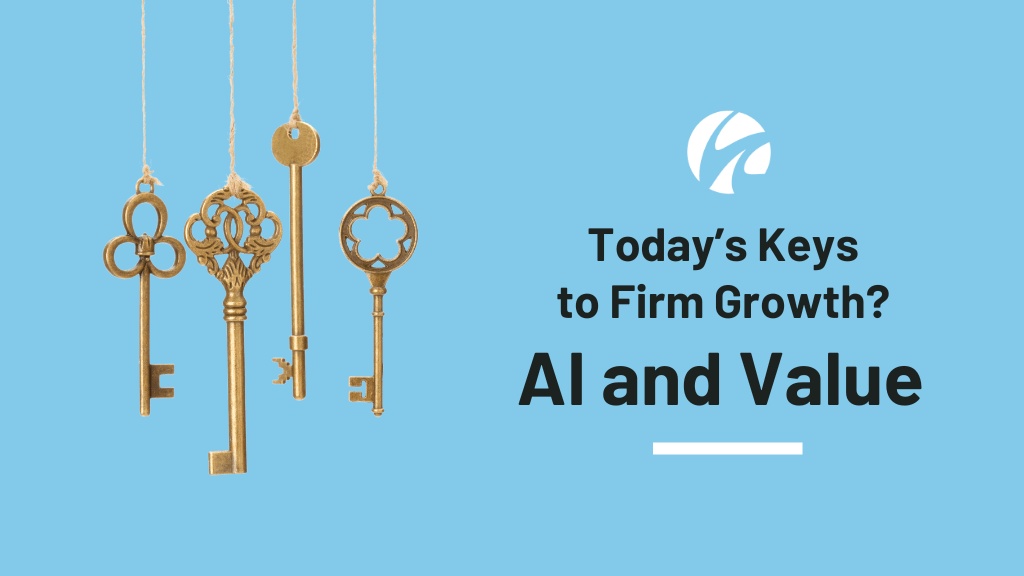6 min read
Building an AI Use Case Roadmap for Accounting Firms
Generative AI is no longer theoretical: it’s already reshaping the accounting profession. Tax software vendors are embedding AI copilots, Big 4...
4 min read
by:
 Brian Blaha
on
Oct 14, 2025
Brian Blaha
on
Oct 14, 2025

Brian is a seasoned CPA firm leader and strategist with decades of experience driving transformation across professional services. A former Chief Growth Officer at Wipfli, he now advises firms and PE groups on leadership alignment, M&A integration, and sustainable, people-first strategy.
Table of Contents

For managing partners, the AI question is no longer “if” but “how”—how to turn investment into measurable value without disrupting firm culture.
In accounting, AI already shows up in tax preparation, audit risk assessment, and financial reporting. The message seems clear: firms that embrace AI will thrive, and those that don’t risk falling behind. But between vendor hype and real-world results lies a harder truth: many firms are spending heavily on AI and seeing underwhelming returns.
Why do some firms thrive with AI while others struggle? The answer isn’t about choosing better technology—it’s about following better implementation processes.
Consider two regional accounting firms. The first accumulates an impressive collection of AI technologies over two years: automated bookkeeping software, AI-powered tax research tools, and predictive analytics platforms. Despite these investments, productivity gains remain elusive and staff adoption is inconsistent.
The second firm takes a systematic approach. Instead of collecting tools, they identify specific business challenges where AI creates value, design implementation processes that integrate with existing workflows, and deploy solutions with rigorous measurement. Their results: measurable productivity improvements, enthusiastic adoption, and new revenue streams.
The difference lies in methodology. Successful AI adoption demands systematic business transformation guided by frameworks that address the organizational, cultural, and operational changes determining whether AI creates value or complexity.
Most AI adoption failures stem from approaching implementation as a technology project rather than a strategic business initiative. Firms either suffer from "shiny object syndrome," testing disconnected tools without strategic coherence, or become paralyzed by the complexity of available options.
The risks of inaction are growing more significant. Top-performing professionals increasingly gravitate toward AI-enabled firms that offer sophisticated work environments and career development opportunities. Traditional compliance services face commoditization pressure as automation makes routine work less valuable. Firms that delay AI adoption struggle to attract younger partners who expect technological sophistication as a baseline rather than a competitive advantage.
What’s missing in most firms is structure: a way to bring order to the chaos and turn AI from an experiment into a repeatable engine of business value. That’s where the Define, Design, Deploy framework comes in.
Rather than chasing tools, the framework forces firms to start with a clear definition of the business problem they’re solving, then design new processes and quality controls that integrate AI responsibly, and finally deploy technology in a way that scales across the organization. This discipline transforms AI from a collection of pilots into a systematic change in how work gets done, developing new professional capabilities and often reshaping the firm’s entire service delivery model.
The Define phase lays the strategic foundation for AI transformation by focusing on use cases with the greatest potential business impact. Successful firms start by mapping operational pain points—Schedule K-1 preparation bottlenecks, client onboarding inefficiencies, or gaps in predictive cash flow analysis—and evaluating where AI offers meaningful leverage.
Our AI Use Case Prioritization Framework for CPA Firms helps leaders systematically score opportunities across two key dimensions: business impact and implementation difficulty. This structured approach ensures firms prioritize quick wins that build momentum, plan for higher-value strategic initiatives, and avoid resource drains that sap capacity without delivering measurable results.
Equally important, the Define phase is where success metrics are locked in. Vague goals like “improve efficiency” are replaced with precise targets such as “reduce Schedule K-1 preparation time from 8 hours to 2 hours per return while maintaining 99.5% accuracy.” These metrics guide design decisions, justify continued investment, and provide proof points for stakeholders.
The Design phase transforms strategic priorities into comprehensive implementation plans addressing technical, organizational, and cultural requirements. Data readiness is a strategic enabler: firms must assess whether existing systems can support AI applications and plan necessary investments in data quality, integration, and governance.
Workflow redesign deserves equal attention. Successful AI implementation rarely involves automating existing processes unchanged; it requires reimagining how human expertise and artificial intelligence combine to deliver superior outcomes. A tax practice implementing AI-assisted return preparation must redesign quality review procedures, redefine professional responsibilities, and establish training protocols that ensure compliance with professional standards.
Professional services firms built their reputations on reliability and accuracy, and implementing AI tools cannot compromise these standards. The Design phase must establish validation procedures for AI-generated outputs, define appropriate professional oversight levels, and create escalation protocols for complex situations. Integration with existing audit documentation standards, tax compliance procedures, and quality control frameworks requires systematic planning.
Client communication strategy deserves parallel attention. Clients need education about AI-enhanced service delivery, clear explanation of how technology improves outcomes, and reassurance about maintained professional oversight. The most successful firms position AI as capability enhancement that enables deeper analysis and more sophisticated insights rather than simple cost reduction.
The Deploy phase emphasizes controlled execution over rapid scaling. Successful firms begin with focused pilots that test assumptions, validate benefits, and refine approaches before broader implementation. A tax practice might pilot AI-assisted partnership return preparation with select clients, measuring accuracy, time savings, and satisfaction before expanding to the entire portfolio.
These pilots require dedicated attention from professionals who can focus entirely on the initiative rather than treating it as an addition to full client workloads. This dedicated focus enables systematic optimization based on real-world feedback, thorough documentation of best practices, and development of internal expertise that becomes organizational capability.
Scaling successful pilots requires transforming individual expertise into organizational capability. This involves developing standardized training programs, creating process documentation that captures both technical procedures and professional judgment guidelines, and establishing quality control frameworks that maintain standards as usage expands.
Continuous optimization distinguishes successful AI adoption from one-time technology implementation. Regular assessment of new capabilities and evolving client needs ensures implementations remain strategically relevant over time.
The Define, Design, Deploy framework represents a fundamental leadership choice about competitive positioning and organizational growth. Market dynamics driving AI adoption will continue intensifying as this technology proliferates. Clients will expect real-time reporting, boards will demand continuous monitoring, and professionals will increasingly select employers based on technological sophistication.
Consider the CPA firm of 2030: routine data entry is gone, handled end-to-end by intelligent systems. Associates spend their time interpreting results and advising clients, not keying numbers into spreadsheets. Advisory work is proactive, driven by predictive analytics and delivered in real time rather than in quarterly or annual reports. Partners focus on high-value activities, solving complex problems, shaping strategy, and deepening client relationships, while AI quietly manages compliance, documentation, and the operational backbone of the firm.
This transformation isn't automatic: it requires systematic AI deployment guided by strategic frameworks. The question for leaders is not whether AI will reshape their firm, but whether they will direct that transformation systematically or have competitors define the future for them.
At Winding River Consulting, we help CPA firms implement AI technologies through strategic planning, use case assessment, and organizational change management. Contact us to explore how systematic AI deployment can accelerate your firm's competitive positioning.
.png)
6 min read
Generative AI is no longer theoretical: it’s already reshaping the accounting profession. Tax software vendors are embedding AI copilots, Big 4...
.png)
6 min read
The traditional accounting firm structure, based on a pyramid of leverage with junior staff feeding work to senior partners, is becoming...

3 min read
Accounting and consulting firms must embrace new pricing models and artificial intelligence to remain competitive in a rapidly changing world. ...